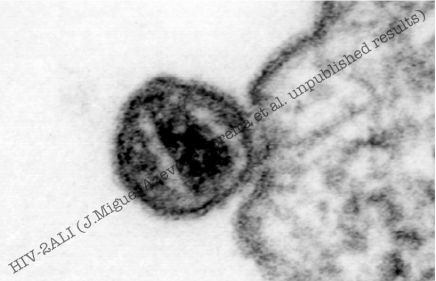
Summary
In this study, an HIV-2 (HIV-2ALI; shown here interacting with a CD4+ T-lymphocyte), that I isolated from an symptomatic patient was used as a model of HIV-2 interaction with host cells.
I deciphered the phenotypic and genotypic features of HIV-2ALI isolate.
The main objective of the work described in this thesis was to study the virus-cell interactions performed by M-tropic variants of HIV-2, using the primary HIV-2ALI strain as a model.
This virus is unable to productively infect any of the CD4+ cell lines tested. Accordingly viral replication cycle was analysed in order to identify the step responsible for this restricted tropism. The results showed that the abortive infection in those cell lines was due to a block at the level of virus entry into target cells.